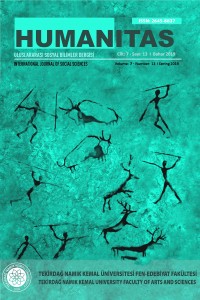Öz
Anahtar Kelimeler
Kaynakça
- Abrams, M. H. A. (2014). Glossary of literary terms. (9th ed.). Boston: Wadsworth Publishing.
- Bakhtin, M. (1981). The dialogic imagination four essays. M. Holquist, (Ed.). C.-, Emerson. M. Holquist, (Trans.). Austin: University of Texas Press.
- Boyd, S. (2000). Introduction: Miguel de Cervantes Don Quixote. London: Wordsworth Editions.
- Cervantes, M. (2000). The Ingenious Hidalgo of Don Quixote of La Mancha. S. Boyd, (Ed.). London: Wordsworth Editions.
- Dudden, F. H. (1952). Henry Fielding: his life, works, and times. Oxford: OUP.
- Fielding, H. (2001). The history of the adventures of joseph andrews and of his friend Mr. Abraham Adams. Devon: Dover Thrift Editions.
- Fielding, S. and Collier, J. (2018). The cry: a new dramatic fable. C. Woodward, (Ed.). Kentucky: University Press of Kentucky.
- Goldberg, H. (1969). The art of Joseph Andrews. Chicago: Chicago University Press.
- Gullón, G. (2005). Don Quijote'nin evrenselliği. (R. Hakmen, Trans.).
- Harris, R. (1990). The purpose and method of Satire.
- Hutcheon, L. (1985). A theory of parody: the teachings of twentieth-century art forms, NewYork: Methuen.
- Kristeva, J. (1980). Word, dialogue, and novel. In L. S. Roudiez, (Ed.), Desire in language: a semiotic approach to literature and art. New York: Columbia University Press.
- Motteux, P. A. (1706). Miguel de Cervantes Don Quixote. London: Sam Buckley.
- Ponseti, H. P. (1988). Cervantes: the writer and painter of Don Quixote. Columbia, Missouri: Columbia University of Missouri Press.
- Scolnicov, H. (1995). An intertextual approach to teaching Shakespeare. Shakespeare Quarterly, 46 (2), 210-219.
- Steinberg, T. L. (2013). Literature, the humanities, and humanity.
- Swift, J. (2009). Bloom’s classic critical views: Jonathan Swift. New York: Infobase Publishing.
- Thrall, W., Hibbard, A. and Holman, C. H. (Eds.). (1960). A handbook to literature. New York: Odyssey Press.
- Ziolkowski, E. J. (1958). The sanctification of Don Quixote: from Hidalgo to Priest. Pennsylvania: Pennsylvania State University Press.
Öz
Cervantes’ novel Don Quixote (1605) has been an inspiration for the works of many artists, and Henry Fielding himself on the title page of his novel accepts that Joseph Andrews (1742) was written in imitation of the manner of Cervantes, the author of Don Quixote. Moving from this point, the ideas developed in this paper are an attempt to study the thematic and formal similarities between Don Quixote and Joseph Andrews with an intertextual approach. In this respect, this article explores such literary elements as satire, parody, picaresque novel, and the Quixotic character employed both in Don Quixote and Joseph Andrews comparatively and this study, hence, argues that reading Joseph Andrews through Don Quixote and a comparison between them will provide the reader with a possibility of new insights about the text.
Anahtar Kelimeler
Kaynakça
- Abrams, M. H. A. (2014). Glossary of literary terms. (9th ed.). Boston: Wadsworth Publishing.
- Bakhtin, M. (1981). The dialogic imagination four essays. M. Holquist, (Ed.). C.-, Emerson. M. Holquist, (Trans.). Austin: University of Texas Press.
- Boyd, S. (2000). Introduction: Miguel de Cervantes Don Quixote. London: Wordsworth Editions.
- Cervantes, M. (2000). The Ingenious Hidalgo of Don Quixote of La Mancha. S. Boyd, (Ed.). London: Wordsworth Editions.
- Dudden, F. H. (1952). Henry Fielding: his life, works, and times. Oxford: OUP.
- Fielding, H. (2001). The history of the adventures of joseph andrews and of his friend Mr. Abraham Adams. Devon: Dover Thrift Editions.
- Fielding, S. and Collier, J. (2018). The cry: a new dramatic fable. C. Woodward, (Ed.). Kentucky: University Press of Kentucky.
- Goldberg, H. (1969). The art of Joseph Andrews. Chicago: Chicago University Press.
- Gullón, G. (2005). Don Quijote'nin evrenselliği. (R. Hakmen, Trans.).
- Harris, R. (1990). The purpose and method of Satire.
- Hutcheon, L. (1985). A theory of parody: the teachings of twentieth-century art forms, NewYork: Methuen.
- Kristeva, J. (1980). Word, dialogue, and novel. In L. S. Roudiez, (Ed.), Desire in language: a semiotic approach to literature and art. New York: Columbia University Press.
- Motteux, P. A. (1706). Miguel de Cervantes Don Quixote. London: Sam Buckley.
- Ponseti, H. P. (1988). Cervantes: the writer and painter of Don Quixote. Columbia, Missouri: Columbia University of Missouri Press.
- Scolnicov, H. (1995). An intertextual approach to teaching Shakespeare. Shakespeare Quarterly, 46 (2), 210-219.
- Steinberg, T. L. (2013). Literature, the humanities, and humanity.
- Swift, J. (2009). Bloom’s classic critical views: Jonathan Swift. New York: Infobase Publishing.
- Thrall, W., Hibbard, A. and Holman, C. H. (Eds.). (1960). A handbook to literature. New York: Odyssey Press.
- Ziolkowski, E. J. (1958). The sanctification of Don Quixote: from Hidalgo to Priest. Pennsylvania: Pennsylvania State University Press.
Ayrıntılar
| Birincil Dil | İngilizce |
|---|---|
| Bölüm | Tüm Sayı |
| Yazarlar | |
| Yayımlanma Tarihi | 22 Mart 2019 |
| Yayımlandığı Sayı | Yıl 2019 Cilt: 7 Sayı: 13 |
Cited By
DOĞU TÜRKİSTAN’DA SOYKIRIM
Bilge Uluslararası Sosyal Araştırmalar Dergisi
https://doi.org/10.47257/busad.1004876









